Computing Tax Liability: Timber Floors Pty Ltd Tax Reconciliation
VerifiedAdded on 2023/06/11
|6
|2416
|447
Homework Assignment
AI Summary
This assignment solution provides a detailed tax reconciliation for Timber Floors Pty Ltd, an Australian resident private company, for the year ended 30 June 2018. The solution begins by differentiating between accounting profit and taxable income, emphasizing the adjustments required to reconcile accounting profit with Australian tax law. Key adjustments include deductions for depreciating assets, such as pooled assets, assets costing less than $1,000, new spray equipment, and trucks, calculated according to specific sections of the Income Tax Assessment Act 1997. The treatment of franked and unfranked dividends, repairs, wages, and trading stock valuation are also addressed, along with the disallowance of certain expenditures and the application of tax offsets like PAYG installments. References to relevant sections of the Income Tax Assessment Act 1997 are provided to support each adjustment.
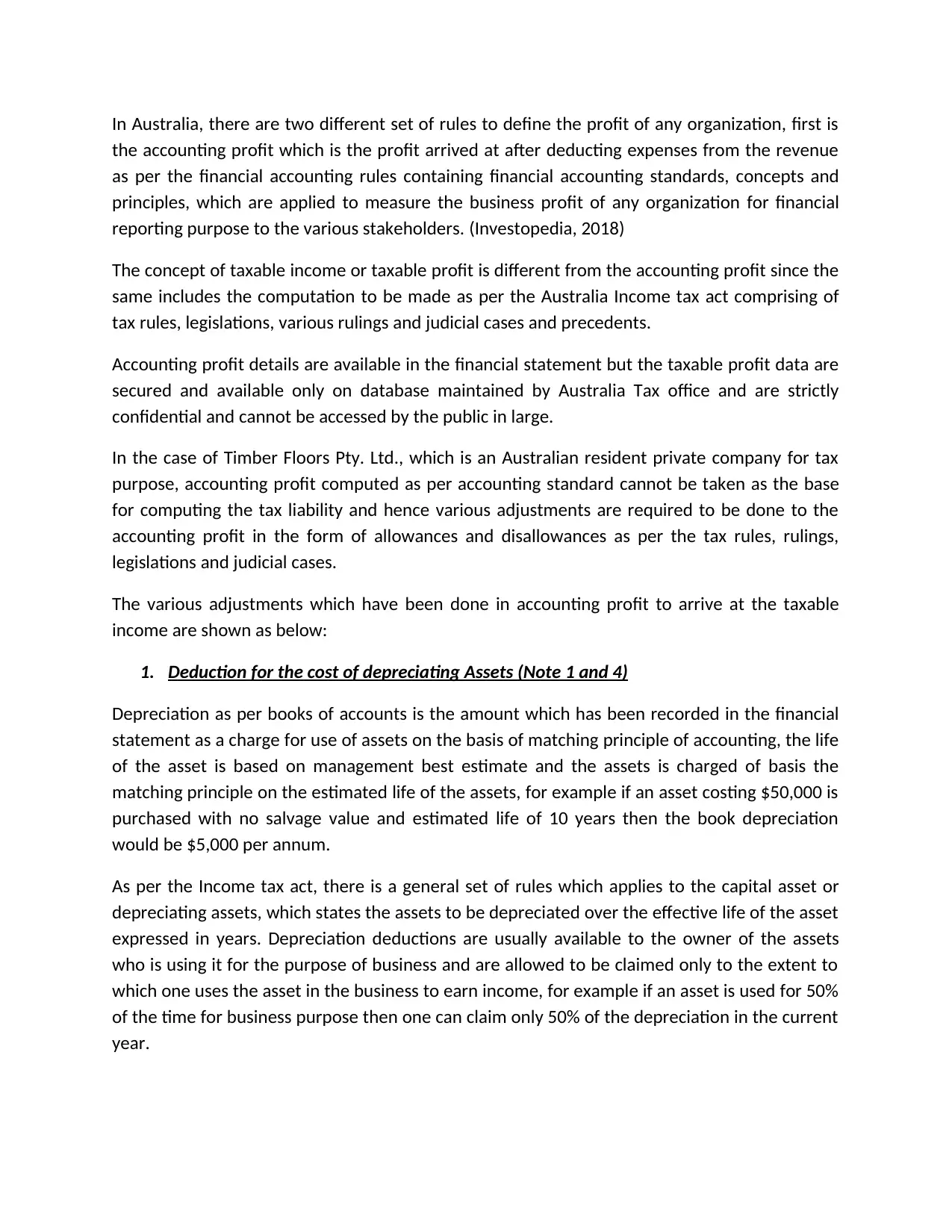
In Australia, there are two different set of rules to define the profit of any organization, first is
the accounting profit which is the profit arrived at after deducting expenses from the revenue
as per the financial accounting rules containing financial accounting standards, concepts and
principles, which are applied to measure the business profit of any organization for financial
reporting purpose to the various stakeholders. (Investopedia, 2018)
The concept of taxable income or taxable profit is different from the accounting profit since the
same includes the computation to be made as per the Australia Income tax act comprising of
tax rules, legislations, various rulings and judicial cases and precedents.
Accounting profit details are available in the financial statement but the taxable profit data are
secured and available only on database maintained by Australia Tax office and are strictly
confidential and cannot be accessed by the public in large.
In the case of Timber Floors Pty. Ltd., which is an Australian resident private company for tax
purpose, accounting profit computed as per accounting standard cannot be taken as the base
for computing the tax liability and hence various adjustments are required to be done to the
accounting profit in the form of allowances and disallowances as per the tax rules, rulings,
legislations and judicial cases.
The various adjustments which have been done in accounting profit to arrive at the taxable
income are shown as below:
1. Deduction for the cost of depreciating Assets (Note 1 and 4)
Depreciation as per books of accounts is the amount which has been recorded in the financial
statement as a charge for use of assets on the basis of matching principle of accounting, the life
of the asset is based on management best estimate and the assets is charged of basis the
matching principle on the estimated life of the assets, for example if an asset costing $50,000 is
purchased with no salvage value and estimated life of 10 years then the book depreciation
would be $5,000 per annum.
As per the Income tax act, there is a general set of rules which applies to the capital asset or
depreciating assets, which states the assets to be depreciated over the effective life of the asset
expressed in years. Depreciation deductions are usually available to the owner of the assets
who is using it for the purpose of business and are allowed to be claimed only to the extent to
which one uses the asset in the business to earn income, for example if an asset is used for 50%
of the time for business purpose then one can claim only 50% of the depreciation in the current
year.
the accounting profit which is the profit arrived at after deducting expenses from the revenue
as per the financial accounting rules containing financial accounting standards, concepts and
principles, which are applied to measure the business profit of any organization for financial
reporting purpose to the various stakeholders. (Investopedia, 2018)
The concept of taxable income or taxable profit is different from the accounting profit since the
same includes the computation to be made as per the Australia Income tax act comprising of
tax rules, legislations, various rulings and judicial cases and precedents.
Accounting profit details are available in the financial statement but the taxable profit data are
secured and available only on database maintained by Australia Tax office and are strictly
confidential and cannot be accessed by the public in large.
In the case of Timber Floors Pty. Ltd., which is an Australian resident private company for tax
purpose, accounting profit computed as per accounting standard cannot be taken as the base
for computing the tax liability and hence various adjustments are required to be done to the
accounting profit in the form of allowances and disallowances as per the tax rules, rulings,
legislations and judicial cases.
The various adjustments which have been done in accounting profit to arrive at the taxable
income are shown as below:
1. Deduction for the cost of depreciating Assets (Note 1 and 4)
Depreciation as per books of accounts is the amount which has been recorded in the financial
statement as a charge for use of assets on the basis of matching principle of accounting, the life
of the asset is based on management best estimate and the assets is charged of basis the
matching principle on the estimated life of the assets, for example if an asset costing $50,000 is
purchased with no salvage value and estimated life of 10 years then the book depreciation
would be $5,000 per annum.
As per the Income tax act, there is a general set of rules which applies to the capital asset or
depreciating assets, which states the assets to be depreciated over the effective life of the asset
expressed in years. Depreciation deductions are usually available to the owner of the assets
who is using it for the purpose of business and are allowed to be claimed only to the extent to
which one uses the asset in the business to earn income, for example if an asset is used for 50%
of the time for business purpose then one can claim only 50% of the depreciation in the current
year.
Paraphrase This Document
Need a fresh take? Get an instant paraphrase of this document with our AI Paraphraser
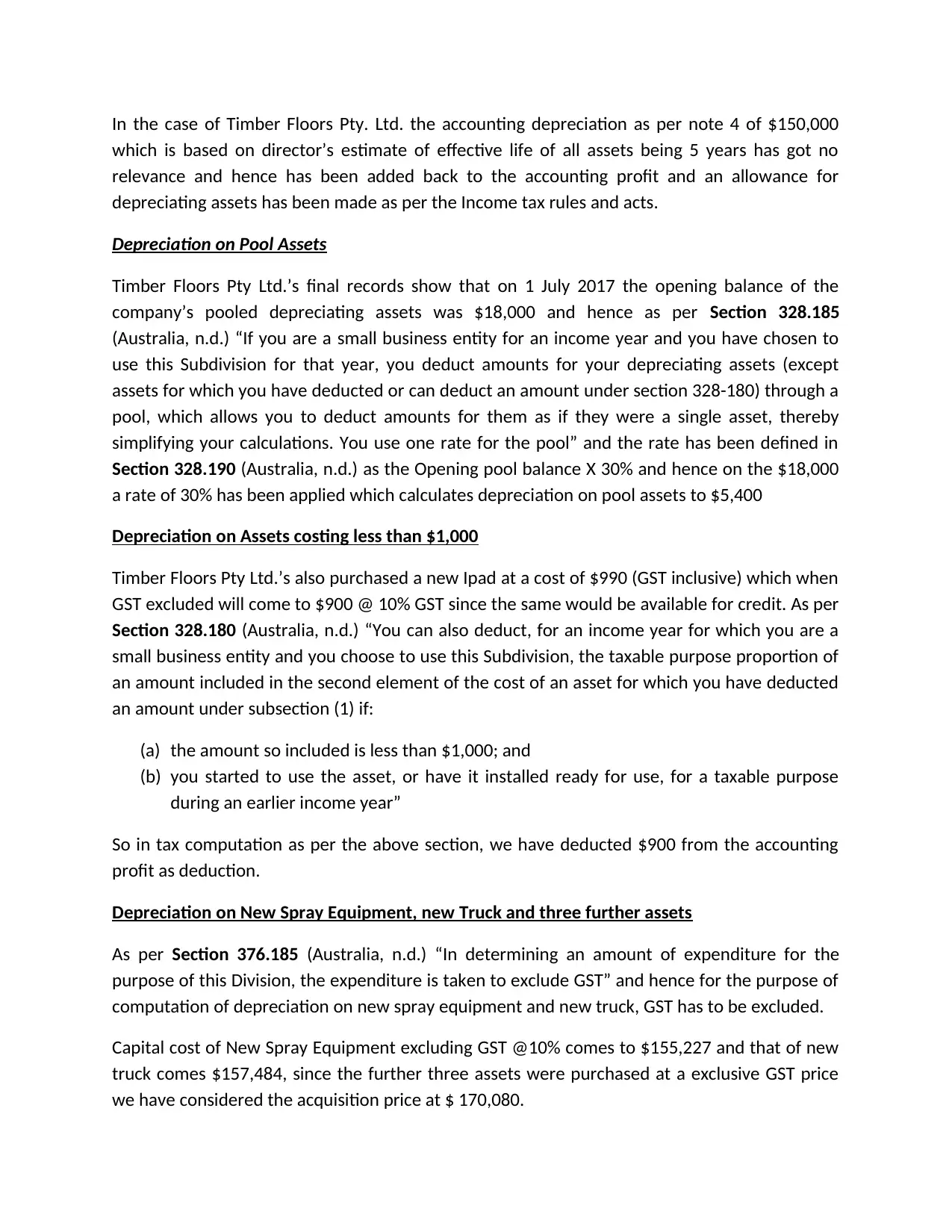
In the case of Timber Floors Pty. Ltd. the accounting depreciation as per note 4 of $150,000
which is based on director’s estimate of effective life of all assets being 5 years has got no
relevance and hence has been added back to the accounting profit and an allowance for
depreciating assets has been made as per the Income tax rules and acts.
Depreciation on Pool Assets
Timber Floors Pty Ltd.’s final records show that on 1 July 2017 the opening balance of the
company’s pooled depreciating assets was $18,000 and hence as per Section 328.185
(Australia, n.d.) “If you are a small business entity for an income year and you have chosen to
use this Subdivision for that year, you deduct amounts for your depreciating assets (except
assets for which you have deducted or can deduct an amount under section 328-180) through a
pool, which allows you to deduct amounts for them as if they were a single asset, thereby
simplifying your calculations. You use one rate for the pool” and the rate has been defined in
Section 328.190 (Australia, n.d.) as the Opening pool balance X 30% and hence on the $18,000
a rate of 30% has been applied which calculates depreciation on pool assets to $5,400
Depreciation on Assets costing less than $1,000
Timber Floors Pty Ltd.’s also purchased a new Ipad at a cost of $990 (GST inclusive) which when
GST excluded will come to $900 @ 10% GST since the same would be available for credit. As per
Section 328.180 (Australia, n.d.) “You can also deduct, for an income year for which you are a
small business entity and you choose to use this Subdivision, the taxable purpose proportion of
an amount included in the second element of the cost of an asset for which you have deducted
an amount under subsection (1) if:
(a) the amount so included is less than $1,000; and
(b) you started to use the asset, or have it installed ready for use, for a taxable purpose
during an earlier income year”
So in tax computation as per the above section, we have deducted $900 from the accounting
profit as deduction.
Depreciation on New Spray Equipment, new Truck and three further assets
As per Section 376.185 (Australia, n.d.) “In determining an amount of expenditure for the
purpose of this Division, the expenditure is taken to exclude GST” and hence for the purpose of
computation of depreciation on new spray equipment and new truck, GST has to be excluded.
Capital cost of New Spray Equipment excluding GST @10% comes to $155,227 and that of new
truck comes $157,484, since the further three assets were purchased at a exclusive GST price
we have considered the acquisition price at $ 170,080.
which is based on director’s estimate of effective life of all assets being 5 years has got no
relevance and hence has been added back to the accounting profit and an allowance for
depreciating assets has been made as per the Income tax rules and acts.
Depreciation on Pool Assets
Timber Floors Pty Ltd.’s final records show that on 1 July 2017 the opening balance of the
company’s pooled depreciating assets was $18,000 and hence as per Section 328.185
(Australia, n.d.) “If you are a small business entity for an income year and you have chosen to
use this Subdivision for that year, you deduct amounts for your depreciating assets (except
assets for which you have deducted or can deduct an amount under section 328-180) through a
pool, which allows you to deduct amounts for them as if they were a single asset, thereby
simplifying your calculations. You use one rate for the pool” and the rate has been defined in
Section 328.190 (Australia, n.d.) as the Opening pool balance X 30% and hence on the $18,000
a rate of 30% has been applied which calculates depreciation on pool assets to $5,400
Depreciation on Assets costing less than $1,000
Timber Floors Pty Ltd.’s also purchased a new Ipad at a cost of $990 (GST inclusive) which when
GST excluded will come to $900 @ 10% GST since the same would be available for credit. As per
Section 328.180 (Australia, n.d.) “You can also deduct, for an income year for which you are a
small business entity and you choose to use this Subdivision, the taxable purpose proportion of
an amount included in the second element of the cost of an asset for which you have deducted
an amount under subsection (1) if:
(a) the amount so included is less than $1,000; and
(b) you started to use the asset, or have it installed ready for use, for a taxable purpose
during an earlier income year”
So in tax computation as per the above section, we have deducted $900 from the accounting
profit as deduction.
Depreciation on New Spray Equipment, new Truck and three further assets
As per Section 376.185 (Australia, n.d.) “In determining an amount of expenditure for the
purpose of this Division, the expenditure is taken to exclude GST” and hence for the purpose of
computation of depreciation on new spray equipment and new truck, GST has to be excluded.
Capital cost of New Spray Equipment excluding GST @10% comes to $155,227 and that of new
truck comes $157,484, since the further three assets were purchased at a exclusive GST price
we have considered the acquisition price at $ 170,080.
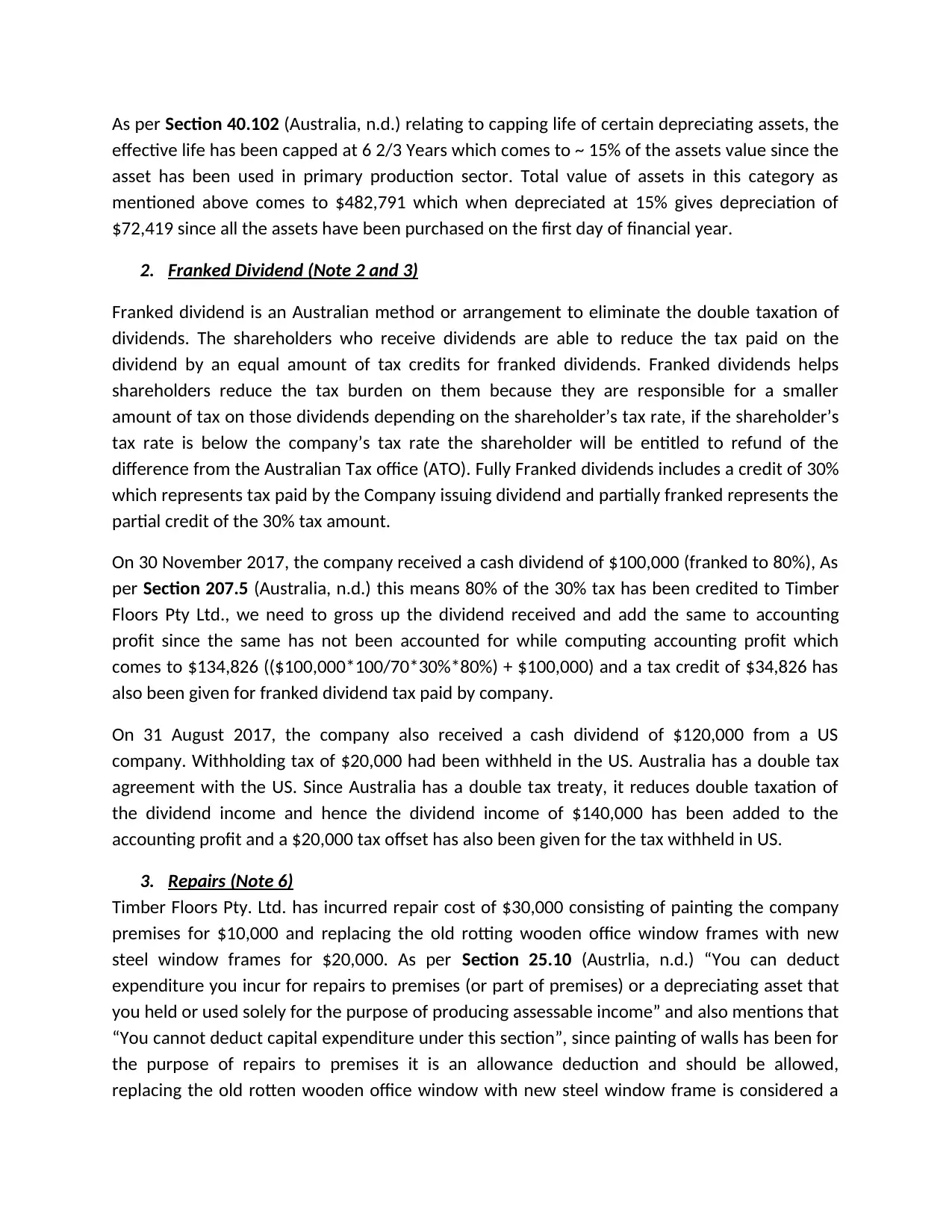
As per Section 40.102 (Australia, n.d.) relating to capping life of certain depreciating assets, the
effective life has been capped at 6 2/3 Years which comes to ~ 15% of the assets value since the
asset has been used in primary production sector. Total value of assets in this category as
mentioned above comes to $482,791 which when depreciated at 15% gives depreciation of
$72,419 since all the assets have been purchased on the first day of financial year.
2. Franked Dividend (Note 2 and 3)
Franked dividend is an Australian method or arrangement to eliminate the double taxation of
dividends. The shareholders who receive dividends are able to reduce the tax paid on the
dividend by an equal amount of tax credits for franked dividends. Franked dividends helps
shareholders reduce the tax burden on them because they are responsible for a smaller
amount of tax on those dividends depending on the shareholder’s tax rate, if the shareholder’s
tax rate is below the company’s tax rate the shareholder will be entitled to refund of the
difference from the Australian Tax office (ATO). Fully Franked dividends includes a credit of 30%
which represents tax paid by the Company issuing dividend and partially franked represents the
partial credit of the 30% tax amount.
On 30 November 2017, the company received a cash dividend of $100,000 (franked to 80%), As
per Section 207.5 (Australia, n.d.) this means 80% of the 30% tax has been credited to Timber
Floors Pty Ltd., we need to gross up the dividend received and add the same to accounting
profit since the same has not been accounted for while computing accounting profit which
comes to $134,826 (($100,000*100/70*30%*80%) + $100,000) and a tax credit of $34,826 has
also been given for franked dividend tax paid by company.
On 31 August 2017, the company also received a cash dividend of $120,000 from a US
company. Withholding tax of $20,000 had been withheld in the US. Australia has a double tax
agreement with the US. Since Australia has a double tax treaty, it reduces double taxation of
the dividend income and hence the dividend income of $140,000 has been added to the
accounting profit and a $20,000 tax offset has also been given for the tax withheld in US.
3. Repairs (Note 6)
Timber Floors Pty. Ltd. has incurred repair cost of $30,000 consisting of painting the company
premises for $10,000 and replacing the old rotting wooden office window frames with new
steel window frames for $20,000. As per Section 25.10 (Austrlia, n.d.) “You can deduct
expenditure you incur for repairs to premises (or part of premises) or a depreciating asset that
you held or used solely for the purpose of producing assessable income” and also mentions that
“You cannot deduct capital expenditure under this section”, since painting of walls has been for
the purpose of repairs to premises it is an allowance deduction and should be allowed,
replacing the old rotten wooden office window with new steel window frame is considered a
effective life has been capped at 6 2/3 Years which comes to ~ 15% of the assets value since the
asset has been used in primary production sector. Total value of assets in this category as
mentioned above comes to $482,791 which when depreciated at 15% gives depreciation of
$72,419 since all the assets have been purchased on the first day of financial year.
2. Franked Dividend (Note 2 and 3)
Franked dividend is an Australian method or arrangement to eliminate the double taxation of
dividends. The shareholders who receive dividends are able to reduce the tax paid on the
dividend by an equal amount of tax credits for franked dividends. Franked dividends helps
shareholders reduce the tax burden on them because they are responsible for a smaller
amount of tax on those dividends depending on the shareholder’s tax rate, if the shareholder’s
tax rate is below the company’s tax rate the shareholder will be entitled to refund of the
difference from the Australian Tax office (ATO). Fully Franked dividends includes a credit of 30%
which represents tax paid by the Company issuing dividend and partially franked represents the
partial credit of the 30% tax amount.
On 30 November 2017, the company received a cash dividend of $100,000 (franked to 80%), As
per Section 207.5 (Australia, n.d.) this means 80% of the 30% tax has been credited to Timber
Floors Pty Ltd., we need to gross up the dividend received and add the same to accounting
profit since the same has not been accounted for while computing accounting profit which
comes to $134,826 (($100,000*100/70*30%*80%) + $100,000) and a tax credit of $34,826 has
also been given for franked dividend tax paid by company.
On 31 August 2017, the company also received a cash dividend of $120,000 from a US
company. Withholding tax of $20,000 had been withheld in the US. Australia has a double tax
agreement with the US. Since Australia has a double tax treaty, it reduces double taxation of
the dividend income and hence the dividend income of $140,000 has been added to the
accounting profit and a $20,000 tax offset has also been given for the tax withheld in US.
3. Repairs (Note 6)
Timber Floors Pty. Ltd. has incurred repair cost of $30,000 consisting of painting the company
premises for $10,000 and replacing the old rotting wooden office window frames with new
steel window frames for $20,000. As per Section 25.10 (Austrlia, n.d.) “You can deduct
expenditure you incur for repairs to premises (or part of premises) or a depreciating asset that
you held or used solely for the purpose of producing assessable income” and also mentions that
“You cannot deduct capital expenditure under this section”, since painting of walls has been for
the purpose of repairs to premises it is an allowance deduction and should be allowed,
replacing the old rotten wooden office window with new steel window frame is considered a
⊘ This is a preview!⊘
Do you want full access?
Subscribe today to unlock all pages.

Trusted by 1+ million students worldwide
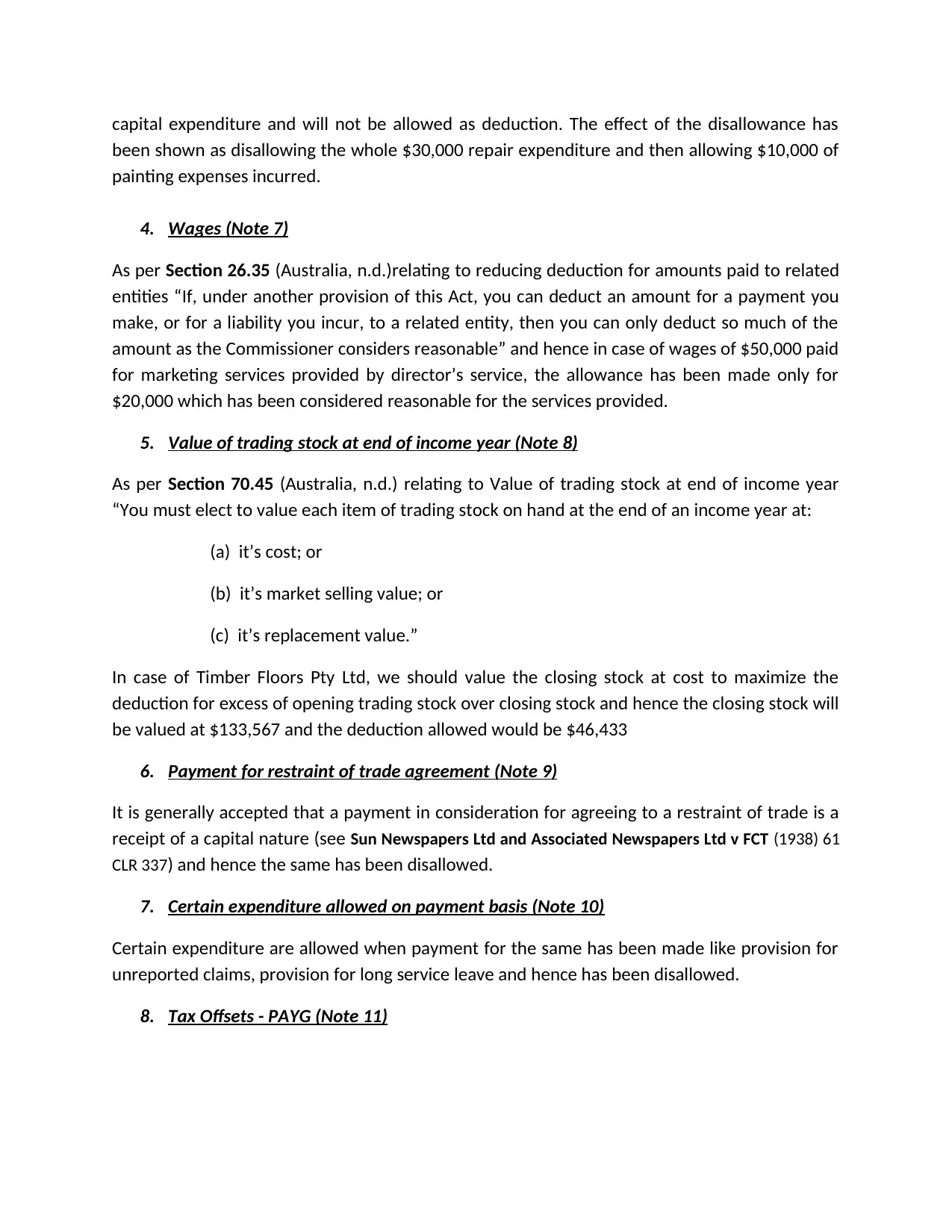
capital expenditure and will not be allowed as deduction. The effect of the disallowance has
been shown as disallowing the whole $30,000 repair expenditure and then allowing $10,000 of
painting expenses incurred.
4. Wages (Note 7)
As per Section 26.35 (Australia, n.d.)relating to reducing deduction for amounts paid to related
entities “If, under another provision of this Act, you can deduct an amount for a payment you
make, or for a liability you incur, to a related entity, then you can only deduct so much of the
amount as the Commissioner considers reasonable” and hence in case of wages of $50,000 paid
for marketing services provided by director’s service, the allowance has been made only for
$20,000 which has been considered reasonable for the services provided.
5. Value of trading stock at end of income year (Note 8)
As per Section 70.45 (Australia, n.d.) relating to Value of trading stock at end of income year
“You must elect to value each item of trading stock on hand at the end of an income year at:
(a) it’s cost; or
(b) it’s market selling value; or
(c) it’s replacement value.”
In case of Timber Floors Pty Ltd, we should value the closing stock at cost to maximize the
deduction for excess of opening trading stock over closing stock and hence the closing stock will
be valued at $133,567 and the deduction allowed would be $46,433
6. Payment for restraint of trade agreement (Note 9)
It is generally accepted that a payment in consideration for agreeing to a restraint of trade is a
receipt of a capital nature (see Sun Newspapers Ltd and Associated Newspapers Ltd v FCT (1938) 61
CLR 337) and hence the same has been disallowed.
7. Certain expenditure allowed on payment basis (Note 10)
Certain expenditure are allowed when payment for the same has been made like provision for
unreported claims, provision for long service leave and hence has been disallowed.
8. Tax Offsets - PAYG (Note 11)
been shown as disallowing the whole $30,000 repair expenditure and then allowing $10,000 of
painting expenses incurred.
4. Wages (Note 7)
As per Section 26.35 (Australia, n.d.)relating to reducing deduction for amounts paid to related
entities “If, under another provision of this Act, you can deduct an amount for a payment you
make, or for a liability you incur, to a related entity, then you can only deduct so much of the
amount as the Commissioner considers reasonable” and hence in case of wages of $50,000 paid
for marketing services provided by director’s service, the allowance has been made only for
$20,000 which has been considered reasonable for the services provided.
5. Value of trading stock at end of income year (Note 8)
As per Section 70.45 (Australia, n.d.) relating to Value of trading stock at end of income year
“You must elect to value each item of trading stock on hand at the end of an income year at:
(a) it’s cost; or
(b) it’s market selling value; or
(c) it’s replacement value.”
In case of Timber Floors Pty Ltd, we should value the closing stock at cost to maximize the
deduction for excess of opening trading stock over closing stock and hence the closing stock will
be valued at $133,567 and the deduction allowed would be $46,433
6. Payment for restraint of trade agreement (Note 9)
It is generally accepted that a payment in consideration for agreeing to a restraint of trade is a
receipt of a capital nature (see Sun Newspapers Ltd and Associated Newspapers Ltd v FCT (1938) 61
CLR 337) and hence the same has been disallowed.
7. Certain expenditure allowed on payment basis (Note 10)
Certain expenditure are allowed when payment for the same has been made like provision for
unreported claims, provision for long service leave and hence has been disallowed.
8. Tax Offsets - PAYG (Note 11)
Paraphrase This Document
Need a fresh take? Get an instant paraphrase of this document with our AI Paraphraser
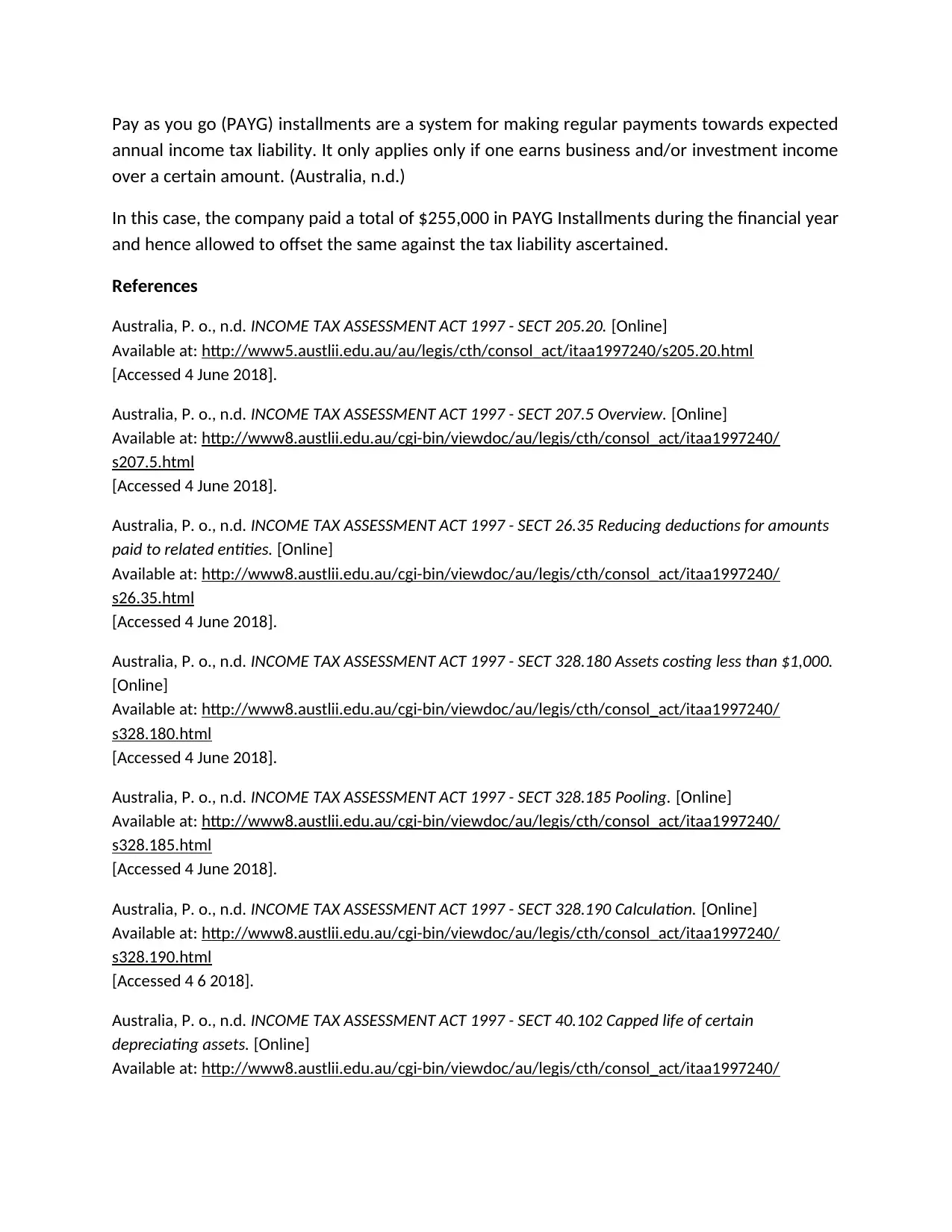
Pay as you go (PAYG) installments are a system for making regular payments towards expected
annual income tax liability. It only applies only if one earns business and/or investment income
over a certain amount. (Australia, n.d.)
In this case, the company paid a total of $255,000 in PAYG Installments during the financial year
and hence allowed to offset the same against the tax liability ascertained.
References
Australia, P. o., n.d. INCOME TAX ASSESSMENT ACT 1997 - SECT 205.20. [Online]
Available at: http://www5.austlii.edu.au/au/legis/cth/consol_act/itaa1997240/s205.20.html
[Accessed 4 June 2018].
Australia, P. o., n.d. INCOME TAX ASSESSMENT ACT 1997 - SECT 207.5 Overview. [Online]
Available at: http://www8.austlii.edu.au/cgi-bin/viewdoc/au/legis/cth/consol_act/itaa1997240/
s207.5.html
[Accessed 4 June 2018].
Australia, P. o., n.d. INCOME TAX ASSESSMENT ACT 1997 - SECT 26.35 Reducing deductions for amounts
paid to related entities. [Online]
Available at: http://www8.austlii.edu.au/cgi-bin/viewdoc/au/legis/cth/consol_act/itaa1997240/
s26.35.html
[Accessed 4 June 2018].
Australia, P. o., n.d. INCOME TAX ASSESSMENT ACT 1997 - SECT 328.180 Assets costing less than $1,000.
[Online]
Available at: http://www8.austlii.edu.au/cgi-bin/viewdoc/au/legis/cth/consol_act/itaa1997240/
s328.180.html
[Accessed 4 June 2018].
Australia, P. o., n.d. INCOME TAX ASSESSMENT ACT 1997 - SECT 328.185 Pooling. [Online]
Available at: http://www8.austlii.edu.au/cgi-bin/viewdoc/au/legis/cth/consol_act/itaa1997240/
s328.185.html
[Accessed 4 June 2018].
Australia, P. o., n.d. INCOME TAX ASSESSMENT ACT 1997 - SECT 328.190 Calculation. [Online]
Available at: http://www8.austlii.edu.au/cgi-bin/viewdoc/au/legis/cth/consol_act/itaa1997240/
s328.190.html
[Accessed 4 6 2018].
Australia, P. o., n.d. INCOME TAX ASSESSMENT ACT 1997 - SECT 40.102 Capped life of certain
depreciating assets. [Online]
Available at: http://www8.austlii.edu.au/cgi-bin/viewdoc/au/legis/cth/consol_act/itaa1997240/
annual income tax liability. It only applies only if one earns business and/or investment income
over a certain amount. (Australia, n.d.)
In this case, the company paid a total of $255,000 in PAYG Installments during the financial year
and hence allowed to offset the same against the tax liability ascertained.
References
Australia, P. o., n.d. INCOME TAX ASSESSMENT ACT 1997 - SECT 205.20. [Online]
Available at: http://www5.austlii.edu.au/au/legis/cth/consol_act/itaa1997240/s205.20.html
[Accessed 4 June 2018].
Australia, P. o., n.d. INCOME TAX ASSESSMENT ACT 1997 - SECT 207.5 Overview. [Online]
Available at: http://www8.austlii.edu.au/cgi-bin/viewdoc/au/legis/cth/consol_act/itaa1997240/
s207.5.html
[Accessed 4 June 2018].
Australia, P. o., n.d. INCOME TAX ASSESSMENT ACT 1997 - SECT 26.35 Reducing deductions for amounts
paid to related entities. [Online]
Available at: http://www8.austlii.edu.au/cgi-bin/viewdoc/au/legis/cth/consol_act/itaa1997240/
s26.35.html
[Accessed 4 June 2018].
Australia, P. o., n.d. INCOME TAX ASSESSMENT ACT 1997 - SECT 328.180 Assets costing less than $1,000.
[Online]
Available at: http://www8.austlii.edu.au/cgi-bin/viewdoc/au/legis/cth/consol_act/itaa1997240/
s328.180.html
[Accessed 4 June 2018].
Australia, P. o., n.d. INCOME TAX ASSESSMENT ACT 1997 - SECT 328.185 Pooling. [Online]
Available at: http://www8.austlii.edu.au/cgi-bin/viewdoc/au/legis/cth/consol_act/itaa1997240/
s328.185.html
[Accessed 4 June 2018].
Australia, P. o., n.d. INCOME TAX ASSESSMENT ACT 1997 - SECT 328.190 Calculation. [Online]
Available at: http://www8.austlii.edu.au/cgi-bin/viewdoc/au/legis/cth/consol_act/itaa1997240/
s328.190.html
[Accessed 4 6 2018].
Australia, P. o., n.d. INCOME TAX ASSESSMENT ACT 1997 - SECT 40.102 Capped life of certain
depreciating assets. [Online]
Available at: http://www8.austlii.edu.au/cgi-bin/viewdoc/au/legis/cth/consol_act/itaa1997240/
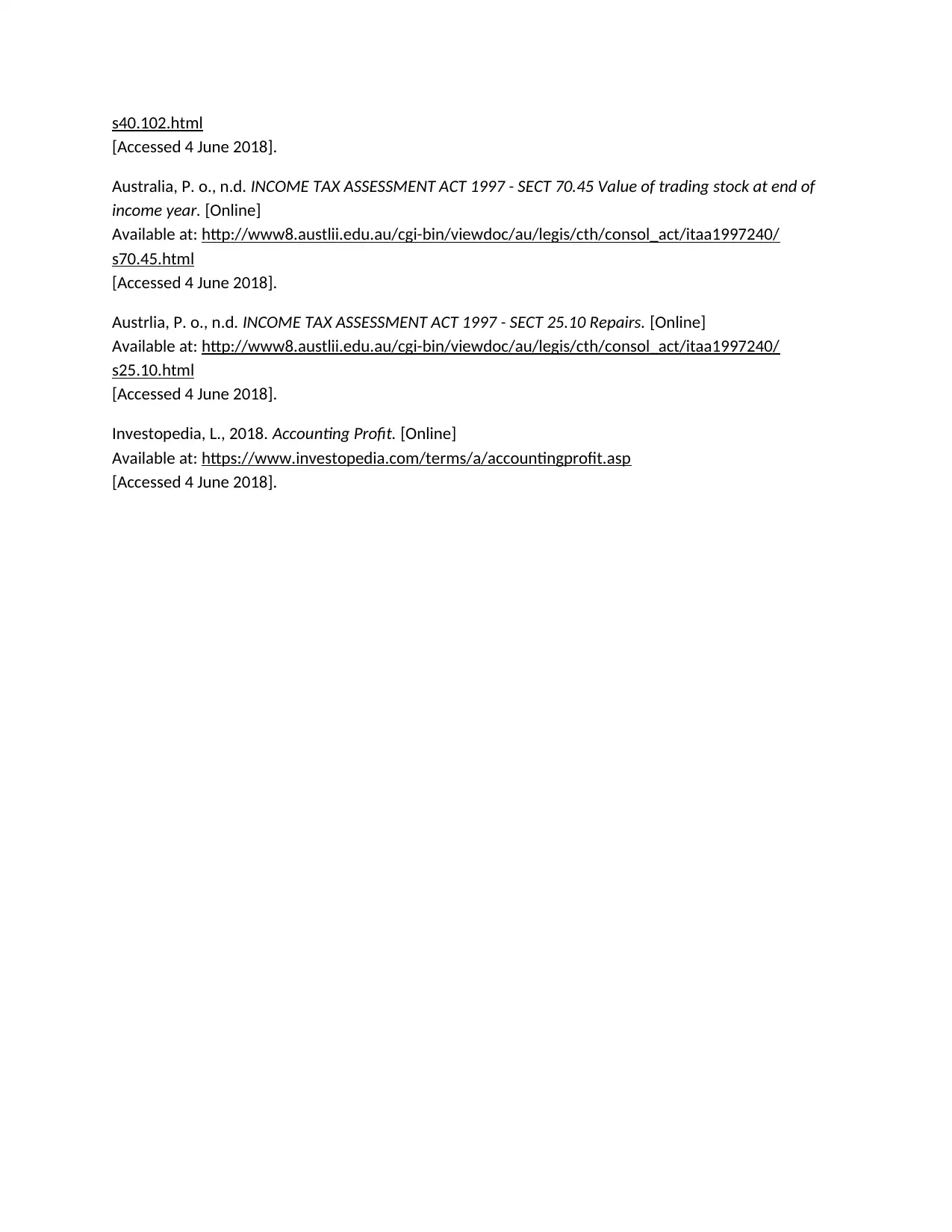
s40.102.html
[Accessed 4 June 2018].
Australia, P. o., n.d. INCOME TAX ASSESSMENT ACT 1997 - SECT 70.45 Value of trading stock at end of
income year. [Online]
Available at: http://www8.austlii.edu.au/cgi-bin/viewdoc/au/legis/cth/consol_act/itaa1997240/
s70.45.html
[Accessed 4 June 2018].
Austrlia, P. o., n.d. INCOME TAX ASSESSMENT ACT 1997 - SECT 25.10 Repairs. [Online]
Available at: http://www8.austlii.edu.au/cgi-bin/viewdoc/au/legis/cth/consol_act/itaa1997240/
s25.10.html
[Accessed 4 June 2018].
Investopedia, L., 2018. Accounting Profit. [Online]
Available at: https://www.investopedia.com/terms/a/accountingprofit.asp
[Accessed 4 June 2018].
[Accessed 4 June 2018].
Australia, P. o., n.d. INCOME TAX ASSESSMENT ACT 1997 - SECT 70.45 Value of trading stock at end of
income year. [Online]
Available at: http://www8.austlii.edu.au/cgi-bin/viewdoc/au/legis/cth/consol_act/itaa1997240/
s70.45.html
[Accessed 4 June 2018].
Austrlia, P. o., n.d. INCOME TAX ASSESSMENT ACT 1997 - SECT 25.10 Repairs. [Online]
Available at: http://www8.austlii.edu.au/cgi-bin/viewdoc/au/legis/cth/consol_act/itaa1997240/
s25.10.html
[Accessed 4 June 2018].
Investopedia, L., 2018. Accounting Profit. [Online]
Available at: https://www.investopedia.com/terms/a/accountingprofit.asp
[Accessed 4 June 2018].
⊘ This is a preview!⊘
Do you want full access?
Subscribe today to unlock all pages.

Trusted by 1+ million students worldwide
1 out of 6
Related Documents
Your All-in-One AI-Powered Toolkit for Academic Success.
+13062052269
info@desklib.com
Available 24*7 on WhatsApp / Email
![[object Object]](/_next/static/media/star-bottom.7253800d.svg)
Unlock your academic potential
Copyright © 2020–2025 A2Z Services. All Rights Reserved. Developed and managed by ZUCOL.




